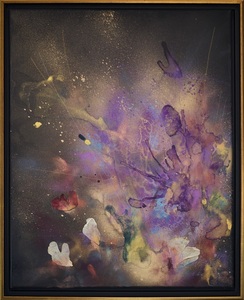Dying Star

In our quest for understanding, we often look to the natural world around us as a vehicle to make sense of our inward struggles. Our own internal chaos seems to be reflected in forests of ancient and newly budding trees, in strands of seaweed that lie along an ocean shore, and, especially, in the random profusion of stars overhead. We look to nature for guidance in the way of signs that we are on the correct path—whether we find it in a shooting star or a fortuitous red sunset (“Red sky at night, sailor’s delight/Red sky in morning, sailor take warning”). We use nature as a metaphor to describe our emotions, projecting our inclinations, intuition, and instincts onto natural incidents, such as an ominous thunderstorm or blustery autumn day. The sky, in particular, we look toward when seeking answers to questions we ask ourselves—or when seeking solace.
For the paintings in the Dying Star series, created using various media including gouache, spray paint, flower petals, and eyeshadow, I have used natural celestial phenomena, such as the Horsehead Nebula, as metaphors for my own rich and sometimes overwhelming experience with personal recovery. The chaos in the night sky seemed the best choice to use as a mirror for the opposing forces of joy and horror I have experienced in the past several years. The metaphor is also universal; thus it is able to be understood by anyone who has looked up to the stars to admire them or to search for answers.
Though the subject matter is opulent, the marks sweeping, and the colors rich and elegant, the paintings are small and portable, inviting the viewer to use them as mirrors for their own internal struggles.



